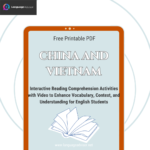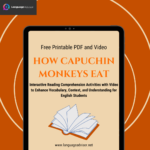The lost tomb of Genghis Khan. Interactive Reading Comprehension Activities with Video to Enhance Vocabulary, Context, and Understanding for English Students. Free Printable PDF
The lost tomb of Genghis Khan
The following day i called him and he said that there were no side effects. For instance, the most common brand medicine is Cataguases brand name cytot. Monsanto é uma marca americana de produtos farmacêuticos que.

Improving reading comprehension is a vital skill for English learners at all levels. It goes beyond just understanding the words on the page, but also involves grasping meaning, context, and intent behind a text. One effective way to enhance reading comprehension is by integrating videos alongside written exercises. Video content can provide visual cues, context, and engagement that help reinforce the learning process. In this blog post, we’ll explore a fun and interactive reading comprehension activity that combines written passages with video resources to deepen understanding and make learning more enjoyable.

The lost tomb of Genghis Khan – Reading Comprehension
Watch the video here:
I’m on a quest to find the secret burial site. The forbidden tomb of the man who ruled one of the largest empires ever known; Genghis Khan.
It’s the most incredible archaeological puzzle of the last millennium.
This is me. Can anybody in this room guess which one is me?
It’s that one, right. And that’s my grandpa and my grandma sitting around all their grandchildren, in Hong Kong.
My grandpa used to tell me all the time that he thought that we had come from the north. And he told me to study hard, to do well in school, but… to be curious about those sorts of things, to try to figure out where we came from; to always know where we came from and who we were.
So, I did study hard. There’s me at a microscope studying hard. And then one day I ended up with this Ph.D. in Engineering! And I thought about my grandpa. I thought about this guy — he grew up at a time of war. And he travelled all over China, but he never made it north. And I thought, ‘I‘m going to do this’. And I saved up a little money and I bought a ticket to China. And I had this plan, I thought that I would go to the outskirts of the capital Ulan Bator, and I’d buy a horse, on the outskirts of the capital. I’m a grad– a fresh graduate student, and I say, “I’m going to buy a horse”.
I didn’t know how to ride a horse! And, I was going to go out into the middle of nowhere and I was going to live with these nomads and when I had to come back I would press “home” on my GPS, get back to the capital; back to the same place that I’d bought the horse, and I would trade it back in for the cash that I had used to buy the horse and then I’d break even and then come home. And I met these two women on this train, these two Mongolian women. And, the next thing, they said they had a brother, and they introduced me to their brother. He agreed to take me up to their uncle’s land, and they would give me a horse.
And there I lived with these nomads. Literally lived with these nomads for months. We think of this place as this far off country; A place of legends, right? And there was one individual whose name was Temujin. He went to this mountain called the Burkhan Khaldun or the God mountain. And he spoke to the sky, to Tengri. And he asked what should he do. What should he do? Should he live this like… this life of being a subservient slave; his wife had just been stolen from him. Or should he fight back. This guy Temujin would one day take on the name Genghis Khan. In Mongolia he’s thought of as a hero. He’s thought of as the great creator of not only their nation but their religion; their spiritual leader.
So why is it that we don’t know this history that the Mongols see? There was never a painting of him during the time that he was alive. There was never a document written about him by his own people while he was alive. There’s literally not a single one of the Imperial family, he or his sons or his grandsons- not a single one of their tombs have ever been discovered. It’s like it was just this whisper of history. But he also created this world which we see today. He had a system of meritocracy, which was far beyond its time. He created the first global currency. He installed a uniform written language that he instated across all of the lands that he dominated. He created the first empire which practiced religious freedom. We don’t really know that much about him, but he changed the world. And maybe if we can go back to this this zone: Ikh Khorig; this forbidden precinct, maybe we can begin to piece his story back from the last bit of evidence that we have then. Then we can start to know more about the truth of this story.
So, that’s me; that’s where I was. I just finished my Ph.D. in Engineering. I thought, ‘Maybe I can start using my mind in a way that will allow me to answer these questions,’. I can use satellite imagery, I’ll get the world’s highest resolution satellite imagery, I’ll use this over the entire region of Ikh Khorig. I’ll scan it with point-five meter resolution imagery, then I’ll use drones with cameras on them, and I’ll take pictures of the earth where the satellite imagery told me things were, a little bit off or weird, or something that looked ancient. Then I’d use things like ground penetrating radar like magnetometry, like electro-magnetic induction to try to scan the ground and find things in the sub-surface that were off. And I would use these tools because the Mongolian belief is that if you disturb the tomb of Genghis Khan– The reason why that area was so forbidden, is because if you disturb this tomb then you might cause this curse that will end the world. But I quickly realized ‘how am I going to find anything? I’ve got 6,000 square kilometers of data in which one pixel is less than half a meter in resolution. I’ve got literally a lifetime of work to do just to sift through this data to find that tiny fragment of information that might be weird.’
This is my data. Can I have people help me find something; something that I don’t even know what I’m looking for. Can anybody tell me if I said if you had to find a tomb, what you would say?
I mean, in this image does anybody see something that looks off? Yeah, right.
These little things? That looks modern, that looks like a river and -what is that?-
We thought ‘That’s simple. So let me make it simple for everybody. Let’s make it easy for people to do this. Let’s make it so that you can tag data easily.’
We chop up all the information into all these tiny little bits and we’ll make it simple and easy for people to see; to place dots and tags on things that they think are weird. And, we built this thing and we put it online we thought, ‘this is how we’ll do it. We’ll create this website where we’ll have people sifting through data. And then every single day, in the field I would download this data with satellite communication links. And I will go and search for those… those sites of interest that are identified by the crowd and then I’d blog back.’
In less than a few months, we started collecting data that exceeded over like, 2.5 million human generated tags. And then when you look a little closer at certain regions you can see each one of these dots is an individual tag by a person who is sitting on their couch in San Francisco, New York, Washington DC and when they converge you start to see things; clusters. When you pulled away the data you see the same tiniest little nuances of something weird.

Questions
What is the primary goal of the narrator?
a) To become a famous archaeologist
b) To find Genghis Khan’s lost tomb
c) To study engineering in Mongolia
d) To explore all of China
How did the narrator’s grandfather influence his quest?
a) By teaching him how to ride a horse
b) By encouraging curiosity about their origins
c) By providing funding for the trip
d) By telling him about famous empires
What technology did the narrator plan to use to assist in the search?
a) Ancient manuscripts
b) High-resolution satellite imagery
c) Traditional maps
d) GPS tracking devices
What did Temujin choose to do after speaking to Tengri?
a) Accept a life of servitude
b) Fight back and become Genghis Khan
c) Travel to the capital city
d) Establish a trade route
Why is the area around Ikh Khorig considered forbidden?
a) It is protected by the government.
b) Disturbing it could invoke a curse.
c) It is too dangerous for exploration.
d) It is inaccessible by road.
Vocabulary Section
Match the vocabulary words with their definitions.
- forbidden
- archaeological
- nomad
- currency
- cluster
Definitions:
a) A member of a people who have no permanent home but move about according to the seasons.
b) Related to or devoted to the study of ancient cultures and artifacts.
c) A grouping of a number of similar things.
d) Excluded from use or mention.
e) A medium of exchange that is presently used, such as money.

Using video in reading comprehension activities not only enhances students’ engagement but also aids in building critical language skills such as listening, vocabulary development, and contextual understanding. By incorporating multimedia into traditional reading lessons, teachers can cater to various learning styles and keep students motivated. We encourage you to try out this method and observe how it transforms reading into a more dynamic, interactive experience for your English learners.

DOWNLOAD THE PDF FOR FREE






